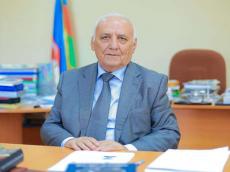|
|
TODAY.AZ / Analytics
Historian says Shahumyan aimed to completely eliminate Turkic-Muslim population from region
01 April 2016 [14:15] - TODAY.AZ

By Amina Nazarli
Director of the History Institute, MP Yagub Mahmudov announced that the mass genocide of Azerbaijani people by Armenians back in 1918 was thoroughly planned and prepared in advance.
“The recent researches conducted by the Institute based on the study of archive documents gave grounds to say that the Dashnaks-Bolshevik regime headed by Shaumyan, who seized power in Baku in November 1917, prepared and systematically carried out criminal action against Azerbaijanis in the spring of 1918.
Tens of thousands of peaceful, unarmed representatives of the Turkic-Muslim population, including Azerbaijani Turks, Lezgins, Tatars and representatives of other ethnic groups, regardless of their gender and age, were mercilessly killed only because of their ethnicity. They even murdered children and women,” the historian told Day.Az.
In 1918, the Armenian gangs committed an act of genocide against the civilian population almost on the entre territory of Azerbaijan. More than 50,000 of Azerbaijani citizens became victims of Armenian fascism in a matter of five months.
Azerbaijanis were exposed to genocide in Baku, the Guba province, Shamakhi, Gusar, Erivan, Nakhchivan, Zangezur, Karabakh, Lankaran and practically on all Azerbaijani lands.
Armenian Bolshevik troops led by Stepan Shaumyan massacred thousands of people, burnt Islamic shrines and confiscated the 400-million-manat estate of Baku residents. Tezepir Mosque was bombed, and one of the magnificent architectural buildings, Ismailiyyeh, was burnt down.
Armenian dashnaks killed 8,027 Azerbaijanis, including 2,560 women and 1,277 children, in 53 villages of Shamakhi, 110 km west of Baku, on March 31. Also, 16,000 Azerbaijanis were murdered in 122 villages of Guba, northern Azerbaijan.
Mahmudov is sure that the main goal of Shaumyan and Dashnak murderers, who accompanied him, was complete elimination of the Turkic-Muslim population, as well as capture of all Azerbaijan and Eastern Anatolia, and establishment of the so-called "Great Armenia".
Mahmudov said that the newly discovered archive documents prove that Stepan Shaumyan, long touted as a "Bolshevik-internationalist" by Soviet historians, was in fact a member of the largest and most radical Armenian terrorist organization - "Dashnaktsutyun" party.
.
Stepan Shaumyan, who was a Baku Armenian and Dashnak masquerading as a Bolshevik, was appointed commissar of the Transcaucasus. He seized absolute power in Baku after the collapse of the Russian Empire and used his position to fight the Azerbaijanis.
The Bolsheviks´ victory in Russia and the withdrawal of Russian troops from the battlefields of World War One opened the way for the massacre in Azerbaijan. Shaumyan took advantage of Armenian officers and soldiers amongst the Russian troops who were returning from the front to Azerbaijan and used them in his anti-Azerbaijani campaign.
“The question arises: why Baku Council disarmed only Muslim army and did not disarmed Armenian militaries, who were mainly deployed in Baku on those days,” Mahmudov said.
“The answer to this question is given by Shaumyan, who admitted afterwards: “We took advantage of the occasion ... and opened the fire on all fronts. We had already had armed forces of about 6,000 people. "Dashnaktsutyun" also had about 3,000-4,000 national units, which were at our disposal. We deliberately went for it ....”
The historian said that Shahumyan motivated his position saying that if Azerbaijani national forces "would have reigned in Baku, the city would have been declared the capital of Azerbaijan."
Mahmudov underlines the necessity to bring the truth about the 1918 March genocide to the world community.
“As the head of the History Institute, I would like to count on greater support, including financial, on the part of the relevant structures, which will expand the scope of our research, to intensify efforts to collect documents relating to the history of Azerbaijan in foreign archives,” he concluded.
In 1918, the Azerbaijan Democratic Republic established a special investigation commission to study the issue, but after the collapse of the Azerbaijan Democratic Republic in 1920, it naturally ceased to exist.
Relevant investigations on the tragedy were carried out and books were published after Azerbaijan gained independence from the USSR in 1991.
President Heydar Aliyev issued a decree on March 26, 1998 to commemorate March 31 as the Day of Azerbaijanis' Genocide
URL: http://www.today.az/news/analytics/149239.html
 Print version
Print version
Connect with us. Get latest news and updates.
See Also
- 18 April 2025 [20:14]
Armenia’s “Crossroads of Peace” lacks substance to deliver regional integration - 18 April 2025 [13:58]
Truth hurts: Armenian media panics after FM’s sovereignty slip-up - 16 April 2025 [19:00]
Baku, Tbilisi: Strategic partners at crossroads of Eurasia - 16 April 2025 [14:42]
Yerevan conceals diplomatic trap for Baku behind peace push - 15 April 2025 [20:12]
Azerbaijan drives strategic transformation of Turkic Council amid global shifts - 14 April 2025 [08:30]
South Caucasus peace paves way for deeper EU–Central Asia integration - 13 April 2025 [13:56]
Armenian FM struggles to defend his country’s constitution - 12 April 2025 [15:15]
Azerbaijan’s strategic role in shifting global order: Deputy Gafarov weighs in - 10 April 2025 [08:30]
President Aliyev's address sets clear message to Armenia on peace at impasse - 09 April 2025 [13:11]
From crisis to cooperation: Azerbaijan’s role in Turkiye-Israel rapprochement
Most Popular
 Antalya Diplomacy Forum becomes center of global dialogue
Antalya Diplomacy Forum becomes center of global dialogue
 The "parallel" worlds of Armenia
The "parallel" worlds of Armenia
 Separatists & Pashinyan - the farce continues
Separatists & Pashinyan - the farce continues
 4SIM signs MoUs with Chinese institutions to boost cooperation in green and industrial technologies
4SIM signs MoUs with Chinese institutions to boost cooperation in green and industrial technologies
 Azerbaijani and Georgian Presidents hold expanded meeting over luncheon
Azerbaijani and Georgian Presidents hold expanded meeting over luncheon
 A fat, nosy and bald hint that Armenia will remove claims against Azerbaijan from the Constitution
A fat, nosy and bald hint that Armenia will remove claims against Azerbaijan from the Constitution
 Foreign diplomats tour liberated cities of Khankendi and Shusha
Foreign diplomats tour liberated cities of Khankendi and Shusha
